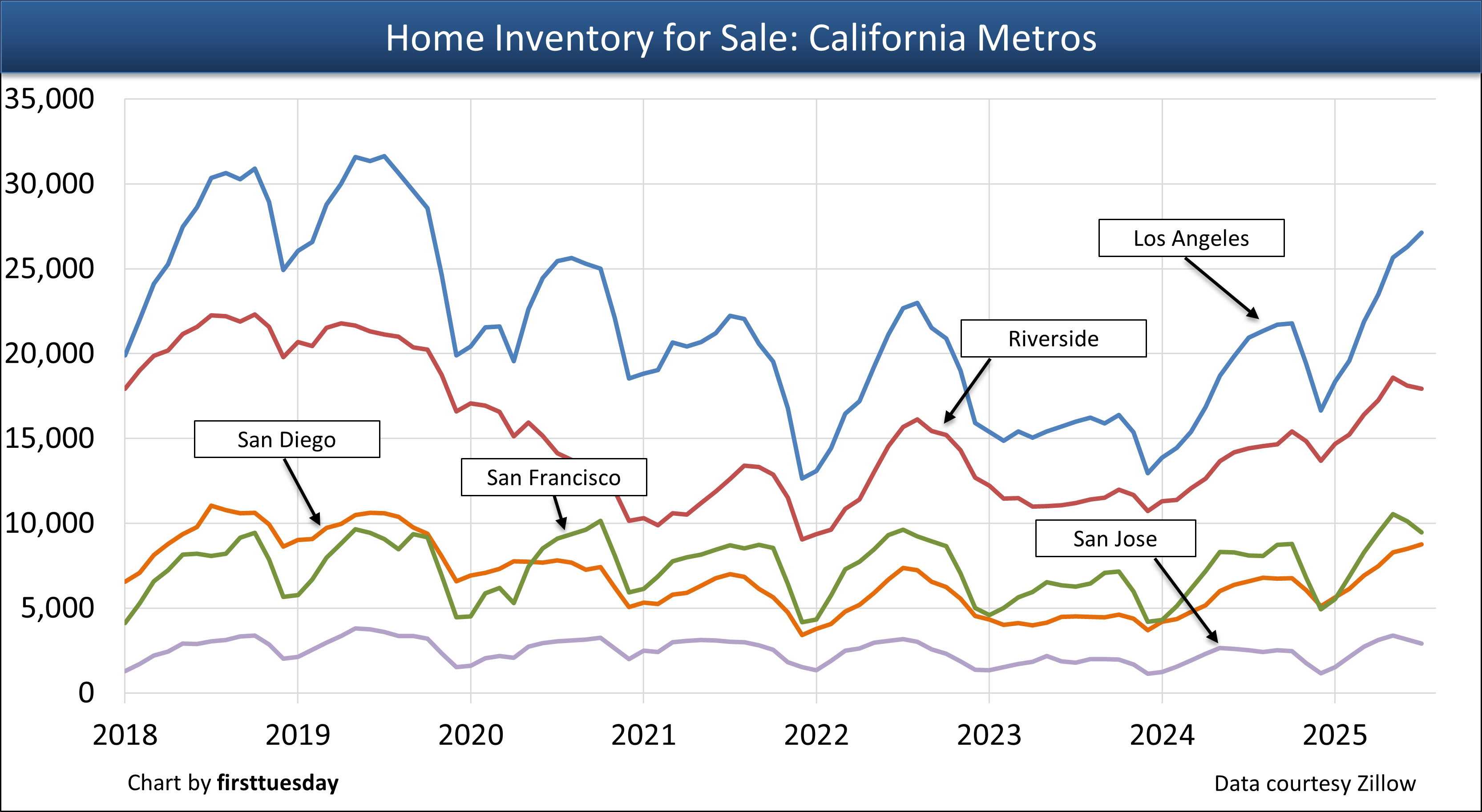Why this matters: Real estate professionals are observing a trend in the steadily increasing inventory of for-sale property, a new experience for those not part of the market in the Great Recession period of 2008. This cyclical inventory event requires an understanding of the consequences of a consistently growing for-sale catalog. Today’s real estate recession, now three years and counting, is extending the average length of time a property is for sale and forcing a reduction in pricing of property intended to be sold.
A buyer’s market has arrived
California’s inventory of homes available for sale is expanding following the unparalleled contraction during the pandemic buying spree of 2021.
For-sale inventory in California’s largest metros averages 25% above a year earlier for July 2025, from data released by Zillow.
The number of properties publicly announced in the market as available for sale through December 2024 ranged from 16-33% above a year earlier in most counties.
In 2025, low-tier priced housing has the lowest level of inventory available for sale or rent. No surprise here, as today’s mid- to high-tier pricing is out of range for most of our employed population.
In contrast, wealthy buyers are historically the first to taper acquiring property and cause an earlier buildup of excess high-tier inventory than lower tiers. Thus, a decline in pricing occurs first in high-tier priced housing followed by mid-tier, then low-tier housing. The wealthy experience a decline in their income before jobholders do, as profits from investments decline before growth in jobholder numbers slow, then peak and eventually drop as witnessed in 2025.
Today’s high price point levels asked by sellers and cyclically higher mortgage rates force buyers reliant on mortgage funding to either:
- wait until sellers reduce their price demands significantly; or
- buy cheaper housing.
Compounding the drag on sales volume, mortgaged owners who purchased or refinanced in the past decade are less willing to sell and upgrade by relocating when mortgage rates and payments greatly exceed those on their present mortgage. Pandemic refinancing is now inhibiting turnover, a significant factor reducing transactions and broker fees.
Further, the California real estate recession underway since mid-2022 has worsened with the sudden 2025 destabilization of global immigration and trade arrangements. Recessions are cyclical events, typically ushering in job and property value losses. These losses place highly leveraged property owners in the position of unconventional sellers, adding to the for-sale inventory without the purchase of a replacement property.
The growth of inventory available for sale has consequences: prices of property begin to decline as sellers seek to attract a buyer from a reduced number of potential consumers. Buyers, confronted with swelling choices and declining prices, initially tend to take a wait-and-see approach before they are willing to step up and acquire a property.
No fear of missing out remains today. The buyer retreat ends when buyers perceive prices have reached their bottom level and sales activity indicates prices are on the rise.
Looking ahead, expect for-sale inventory to increase in 2025 and beyond until the first drove of speculative buyers enters the market, not likely an influence before 2028 without a stock market crash.

Chart update 9/11/25
| July 2025 | July 2024 | Annual change | |
| Los Angeles for sale inventory | 27,100 | 20,950 | +29.5% |
| Riverside for sale inventory | 17,900 | 14,500 | +24.5% |
| San Diego for sale inventory | 8,700 | 6,600 | +32.8% |
| San Francisco for sale inventory | 9,500 | 8,100 | +16.6% |
| San Jose for sale inventory | 2,900 | 2,500 | +15.5% |
The previous seller’s market fully reversed in mid-2022 and has developed into a full-blown buyer’s market. This shift in buyer demand for real estate began with the 2013 cyclical end to ever-lower mortgage rates after 1982, introducing our present roughly 30-year half cycle of generally rising mortgage rates. As for real estate agents in property sales and leasing, a steady income from fees in 2025-2028 will require a pivot by agents to include cash-heavy users, whether owners or tenants, residential or commercial.
A buyer with the willingness to buy property and ability to use savings to acquire a home has a logic for buying now. The justification for the high price paid for a purchase today, not later, is the offset in present value created by the difference between:
- the interest rate on a mortgage avoided by using savings; and
- the interest rate on the savings used to purchase the property.
Buyer interaction with the gatekeepers is now enhanced as confidence in the acquisition of real estate rises due to the 2025 advent of representation agreements mandated for use by agents who expect to earn – and keep – a fee for assisting a buyer.
Expect property prices to bottom around 2028, but only after government chaos is controlled. As always, a timeline is complicated by disruptions in jobs and attitudes brought on by abnormal shifts in economics due to international turmoil and the vicissitudes of inconsistent government action.
Related article:
The cure for an inventory shortage
California’s decade-long inventory imbalance and related housing crisis of low-tier availability have two reasonable bases for resolution:
- decreased demand, via an increase in the number of occupants per existing dwelling or parcel of real estate, a recession-related phenomenon; and
- construction of residential units, enforced and funded by state programs for low-tier priced housing necessary to support the local workforce in a recovery.
The years beyond 2025 will see a bit of both. Residential construction is staged to increase.
Homeownership and rental vacancies are below normal rates for the present level of household income in California. This occupancy stress is due to local and statewide inability – resistance – to permit new construction of housing units sufficient to house individuals employed in a community. The concept of “live where you work” is yet to catch on with local inhabitants.
To that end, several pieces of new legislation since 2017 focus on the construction of more dwellings in communities in California. However, only a few inclusive communities willing to deliver long-term housing policy have addressed the permitting issue with a positive reaction. Some officials in coastal communities are being judicially forced to allow permits for additional low-tier housing to skirt the politically pervasive NIMBY groups.
Unless a community permits low-tier housing starts, the community will need rent control ordinances to house those families employed locally. It’s either one or the other, as coastal communities have discovered.
Related article:
















If the lender finds a lease agreement with a duration that is greater than three years, they have the legal right to call in the mortgage.
Carrie –
With all due respect, the low housing inventory has little to do with interest rates. In past years, interest rates have been as high as 10% without having this kind of impact on sellers reluctance to sell their homes. The real culprit is capital gains tax. The federal government has failed to adjust the exemption amount in over 25 years. People don’t want to pay a huge tax bill just for selling their home. Email me if you would like more info.